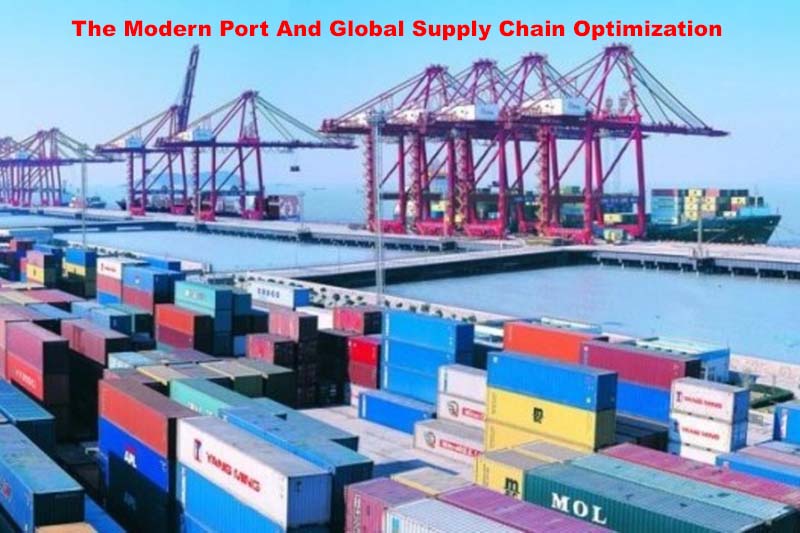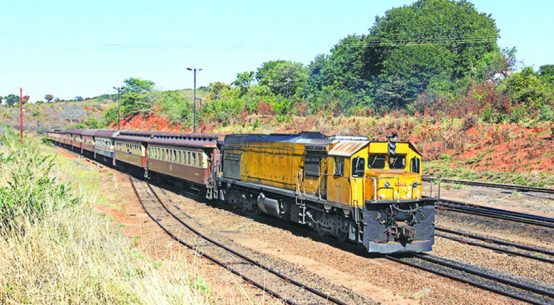
The Modern Port And Global Supply Chain Optimization: Photo: Port of Ningbo Zhoushan, China

No matter how information technology advances, the world trade cannot be materialized without ports. This is exactly why every country needs to develop much more advanced and efficient ports for its prosperity
– Dr. Mahathir, former Prime Minister of Malaysia
INTRODUCTION
Ports today face two competitive challenges the large increase in volumes and the need for greater efficiency. This paper will identify catalysts for the optimum future development of port infrastructure as well as the implication on export competitiveness, port commerce, inter-port co-operation and competition. It will also provide a framework for improving integrated logistics network as a tool for utilizing the full capabilities of modern ports, provide some insights on the cost of poor logistics to country competitiveness and the sources of those higher costs. Beyond cost and time taken to deliver goods, it will also delve into the predictability and reliability of supply chains.
Seaports and Supply Chains
Ports, as members of a supply chain and a part of a cluster of organizations, have a huge role to play for seamless operations. These roles include:
- relationships between the port operators and the focal firm
- supplied services that add value
- information and communication technologies
- performance measurement indicators common to supply chain partners and
- introduction of the logistics concepts of lean and agile
The challenges facing shipping and the world’s ports today are not only related to the quantity but also the quality of services. The continuous progress of globalization of shipping and trade business is resulting in increasing pressures on ports cost and improve operational efficiency.
The Role of Modern Seaports
The role of modern seaports involves integration in the supply chain. Fulfilling this role means greater ability of the port to satisfy customers and achieve its objectives. On this basis, it is hypothesized that specific measures of integration in the supply chain will be positively related to specific measures of port performance and competitiveness the measures themselves reflecting contemporary logistics goals and not merely traditional efficiency measures.

Key Challenges Faced within a Global Logistics Network
Achieving True Excellence within a Global Supply Chain is as much a journey as it is a goal. The key challenges which ports face within the global logistics network include:
- lengthening of the supply chain
- difficulty & cost inefficiencies in transportation execution
- lost sales/mismatch in supply & demand
- import/export compliance procedures
- disconnect between international and domestic transportation
- lack of strong technology support
- lack of experience and skill sets
Characteristics of a World-Class Transportation Logistics Network
The characteristics of a World-Class Transportation Logistics Network include:
- optimal design of global supply chain
- integrated planning and execution processes
- integrated international and domestic logistics
- global logistics visibility
- dynamic logistics routes
- logistics process automation
- collaboration with supply chain partners
- compliance with changing regulations
- making the financial supply chain connection
Competitive Performance Measures for Ports
Marlow and Paixao (2003) and Tongzon and Heng (2005), among other writers, had identified the following five competitive performance measures for ports:
- Price (Cost Advantage)
- Quality
- Reliability
- Customization
- Responsiveness
Laggards are taking the full brunt of rate increases and capacity/performance shortfalls while leaders are taking action to avoid these problems by:
- trying to improve overall service and financial performance
- investing in the right place
- focusing on value
- thinking end to end
- Leverage technology (network design, logistics, visibility, analytical solutions, )
- tapping local talent
- manage risk
In other words, Leaders act as internal XPL s or even as profit centres and every transport move has a buy-side and a sell-side.
Contemporary Developments
Contemporary developments in maritime transport and logistics indicate that ports should play an important strategic role as a member of a supply chain that involves sea and inland transportation.
There are six parameters that account for most of the variation in the degree of seaport integration in logistics and supply chain management.
These parameters are
- adoption of information and communication technologies,
- relationships with shipping lines,
- value-added services,
- inter-connectivity/inter-operability with inland modes of transport,
- relationships with inland transport operators and
- channel integration practices and performance
Infrastructure and Export Competitiveness
Infrastructure development is a key element of a country s ability to produce and move goods. O Rourke and Williamson (1999) argue that all of the commodity market integration in the Atlantic economy after the 1860s was due to the fall in transport costs between markets…
Weak infrastructure is a major impediment to trade, competitiveness and sustainable development in most African countries. Recent literature has emphasized the dependence of trade costs on infrastructure.
Trade costs
Trade costs can be defined as the cost of transaction and transport associated with the exchange of goods over and above the marginal cost of production. Broadly defined, trade costs include all costs incurred in getting a good to a final user other than the marginal cost of producing the good itself.
Such costs include transportation costs (both freight costs and time costs), policy barriers (tariffs and non-tariff barriers), communication costs, utility costs, and local distribution costs (wholesale and retail).
Trade Competitiveness
Improved trade logistics and facilitation can improve competitiveness by:
- Increasing profitability of existing exports and encouraging expansion in production.
- Reducing delivery time and cost of imports, benefiting both domestic & export sectors.
- Allowing manufacturers to enter high-value market segments e.g. premium garments requiring shorter delivery cycles.
- Opening up new markets e.g. horticulture – flowers, fruits, etc.
In addition to the macro incentive regime, what is also important is that firms have access to efficiently-produced critical backbone services and inputs. Countries where firms have to pay more than their competitors for energy, telecommunications, customs services, transport, logistics, and business registration and operations, will find it hard to compete in the global markets.
INTERNATIONAL SCORECARD
The international score uses six key dimensions to benchmark countries’ performance and also displays the derived overall LPI index.
The scorecard allows comparisons with the world on the six indicators and the overall LPI index.
The logistics performance (LPI) is the weighted average of the country scores on the six key dimensions:
- 1) Efficiency of the clearance process (i.e., speed, simplicity and predictability of formalities) by border control agencies, including customs;
- 2) Quality of trade and transport related infrastructure (e.g., ports, railroads, roads, information technology);
- 3) Ease of arranging competitively priced shipments;
- 4) Competence and quality of logistics services (e.g., transport operators, customs brokers);
- 5) Ability to track and trace consignments;
6) Timeliness of shipments in reaching destination within the scheduled or expected delivery time.
The World Bank Ranking
Countries that have high rankings and/or have shown significant gains have done so by showing consistently superior performance in key macro and microeconomic areas:
- Macroeconomic environment: high budget surpluses, low government waste, strong country credit rating, low inflation
- Strong public and private institutions: absence of corruption, business and governmental transparency, judicial independence, enforcement of property rights
- Technology and innovation: high spend on research and development (R&D), aggressive adoption of new technologies, university and industry research collaborations, active use of technology
- Education and training: high educational enrolment rates, excellent educational establishments, skilled labour force.
A Robust Benchmark
The World Bank report, the Logistics performance index rankings and indicators provide robust benchmarks that may help policymakers – and particularly the private sector – to build the case for reform. By showing countries how they compare with their competitors and shining a light on the costs of poor logistics performance, it is hoped that the LPI and its indicators may help countries break out of the vicious circle of logistics unfriendliness. We cannot agree any less with this final conclusion. As one writer put it recently when it comes to global supply chains performance, you better be good. This is a warning not only for globally aspiring companies but also for any nation that aspires towards achieving global competitiveness in this 21st century.
Attacking Supply Chain Disruptions
The recent rise in a number of calamities and the terrorist acts has brought much attention to the vulnerabilities of supply chains. Having passed through many hands that span continents and entities, the reliability and timeless of freight delivery become increasingly difficult to be assessed. Particularly, at seaports which is an indispensable node in global supply chain and where complex sea and land interfaces come into play. The changing functions of ports and the current supply chain trends denote implications that when identified, will allow better development of mitigation strategies for ports.
In global supply chains, seaports are critical nodes where value-adding logistics-related activities take place. However, as processes and operations in the ports increase in their complexities and range, the integration of port into supply chain management creates a higher level uncertainties for downstream planning, product movement as well as information exchange. For that reason, deficiencies in the ports are capable of developing into augmented unsought effects down supply chains. To make matters worse, supply chain trends and practices increase the likelihood of a disruption occurring and exacerbate the effects of disruptions.
There are several models looking at how to optimize supply chain in spite of disruptions at the port. This model uses a three-phase approach:
Robust Supply Chain Strategies
Given these challenges and vulnerabilities, companies look for ways to strike a balance between cutting costs in daily supply chain operations, remaining agile and mitigating risks.
Possible supply chain risk mitigation strategies that can improve the efficiency, flexibility and responsiveness of your supply chain include:
- Postponement: Delay the point of product differentiation by producing a generic product based on total product demand, then customize when necessary. This allows for a cost and time-effective way to reconfigure a product quickly should there be a supply disruption. Dell uses postponement, allowing for substitute configurations should certain parts not be available.
- Rebalancing of the supply chain: Have more than one supplier to be able to immediately switch to in the case of disruptions and maintain a flexible supply base. One of the most well-known examples of the importance of having a flexible supply chain is where two companies supplier bases’ allowed them to react differently to a supplier’s plant disruption. In 2000, a Philips microchip plant had a fire that contaminated most of the plant’s stock of microchips. While Nokia was able to work with Philips and their other suppliers to secure a stock of chips, as well as re-engineer some of their phones to fit other chips.
- Make-and-outsource: Make some products in-house and outsource some production, allowing firms to shift production locations quickly if necessary.
- Flexible modal choices: Logistics companies are often hindered by pre-defined routes and trade lanes. However, having a flexible and diverse logistics strategy that relies on multiple modes of transportation, multiple carriers, and multiple routes will allow logistics companies and their customers to remain agile, should the routes need to be changed.
CONCLUSION
The evolutionary developments in port functions through three generations usually refer to changes in types of cargo received, port activities and members as well as the degree of involvement of the port community. The post containerization era witnessed marked progress in value-addition and increasing integration into supply. With the growing importance of port hinterland, coordination and cooperation with other transport nodes create anticipated means of creating synergies. However, some players in a port supply chain have operational relationships but not contractual relationships and the degree of integration of the chain will be reduced due to the lack of contractual relationships between the parties. Besides, the lack of contractual relationship can also cause variabilities and uncertainties in the port supply chain system.
Dr. Madu is the CEO Multimix Export House; Director General African Centre for Supply Chain and a recipient of the 2014Nigeria National Productivity Order of Merit Award. He can be reached at omadu@multimix-academy.com You can follow Dr. Obiora Madu on LinkedIn or on Facebook to gain more insights on the topic.









